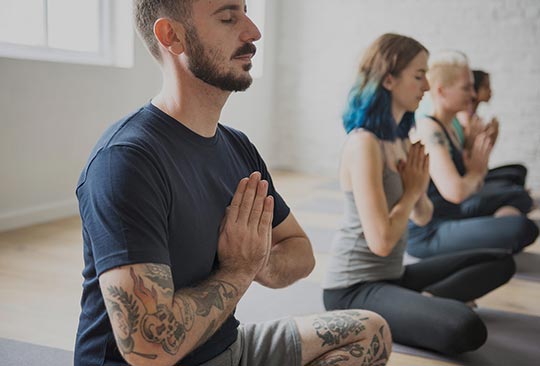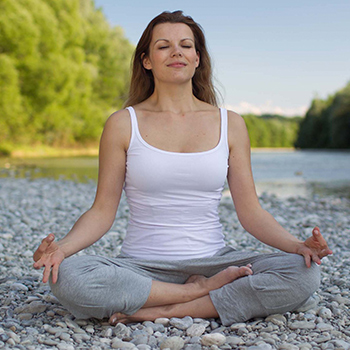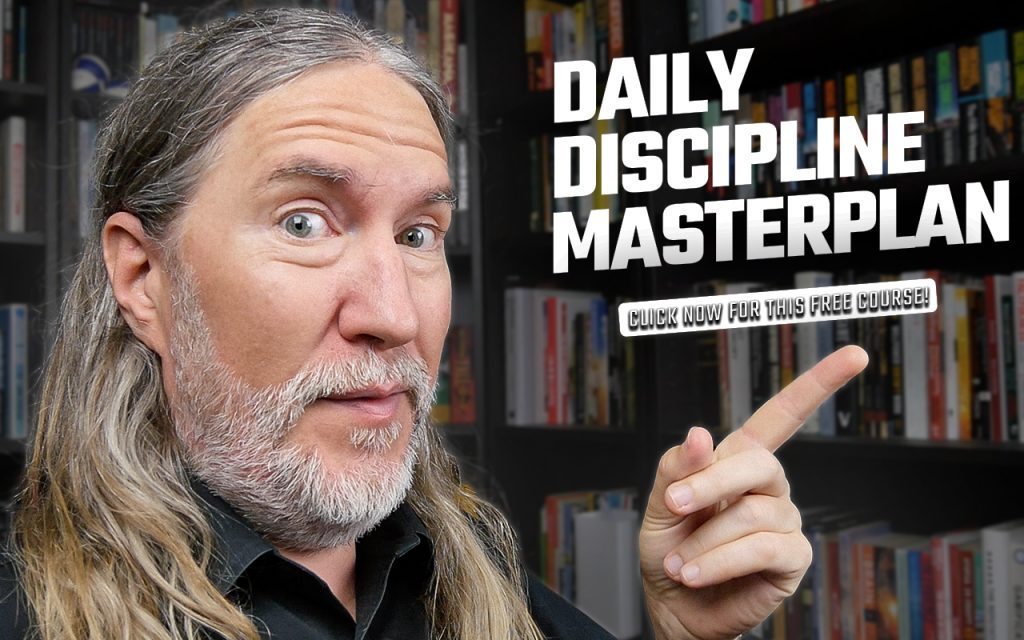Of all the kinds of meditation out there, self care meditation is the best.
Why?
Because it is your “self” that needs care more than anything else if you’re ever going to help anyone else.
So when it comes to self care and meditation, let’s dive in what this form of meditation is all about and how to benefit from a consistent practice.
What Is Self Care Meditation?
I feel that it’s best to define “self” first. That way you can get the benefits of self meditation quicker.
As far as I can tell, the self is defined in at least two ways:
1) The illusion that you are an individual, perhaps one that changes when you implement one or more personal development activities.
2) The notion of the Self in spiritual traditions like Advaita Vedanta. Here, the traditions talk about each person as a manifestation of a larger collective mind.
In other words, there is an illusion of you, but it’s illusory nature doesn’t mean you don’t experience it as “real.” You do. But it’s human (all too human) and easy to mistake it as special or unique, which in turn makes the appearance of suffering much worse than it needs to be.

But to meditate on the self is very powerful because it helps resolve contradictions between these competing ideas of being a unique individual vs. being a manifestation of a brain that shares nearly everything in common with every other brain – at least when it comes to consciousness. When you resolve these tensions, many other stresses in live begin to dissolve.
Neuroscientist Sam Harris has devoted a lot of pages and hours on his podcast to helping people dissolve the notion of the individual self. For years, he was a bit weak on the second definition. He even said in a private “Ask Me Anything” that he didn’t mention various spiritual texts he’d studied because he didn’t want people wandering off into fanciful territory.
He seems to have softened in that regard because now the Waking Up app is packed with all kinds of teachers who address these issues. Take Adyashanti for just one example.
In sum, to care for yourself, your first task is to meditate on the self. There are no easy answers here, but most people concede that you can neutralize much conflict in life by resolving the notion that there is a “you.” Here’s a quick description of how this problem of the self has been resolved for me through self care meditation:
Self Care Ideas For Meditation And Yoga
There are a number of ways to reach a state of bliss that lasts. Here are some of my favorite.
-
Read Widely
Since the ego has its fingers on everything, you’ll often find territorialism in both spiritual and scientific texts. For the best possible experience, you want to broaden your reading so that it encompasses both.
Happiness Beyond Thought is one of my favorite books and it includes a nice reading list at the back. It also works to incorporate the best of contemporary science with the best elements from a variety of spiritual traditions.

Other books worth reading include:
- The Book of Undoing by Fred Davis
- The Fire of Self-Knowledge by James Swartz
- Waking Up by Sam Harris
- Standing As Awareness by Greg Goode
- Flight of the Garuda, edited by Keith Dowman
- How Enlightenment Changes Your Brain by Andrew Newburg and Robert Waldman
- The Surrender Experiment by Michael Singer
- Why Buddhism is True by Robert Wright
- The Power of Now by Ekchart Tolle
My own entry is called The Victorious Mind: How to Master Memory, Meditation and Mental Well-Being. It refers to most of the above and many more.
-
Create a Meditation Habit Stack
Instead of sticking to just one kind of meditation, find ways to combine several. Qigong has interesting ways of doing this already, but ultimately, you want to develop your own.
As I reflect on the nature of the self and the Self, I like to combine:
- Stretching
- Sitting
- Chanting
- Journaling
- Walking
- Memory exercise
To really focus on meditation as self care, consider remembering to inquire into the nature of the self as you stretch.

As Gary Weber talks about in Happiness Beyond Thought, you can answer any thoughts that arise while you’re stretching with “neti neti.” (Not this, not this.)
Although it might feel unusual to negate the idea that you are a self while stretching, soon you’ll realize that you are experiencing the larger Self. When you continue to seek for the idea of your own individuality and some sort of concrete manifestation it feels like it should be, the notion will dissolve.
Likewise when you’re walking. You can ask questions like, “Who is it that experiences this street?” If you can find the ego inside of you who does the experiencing, you’ll have done better than me. When I do this practice, all I can find is the experience of consciousness, a.k.a. the experience of Self we all share.
-
Multi-sensory experiences
Listening to chants and producing them is a great way to conduct your self care meditations. But you can also add tactile sensations by adding in kirtan kriya.
If you’re journaling, you can listen to music, or speak what you’re writing out loud as you compose.
You can also chant while using the cold shower technique.
A Script For Self Care Meditation And Mindfulness
Guided visualizations are another way to develop powerful self care meditations. Here are some general guidelines to follow:
- Be specific and create a goal. What about your self do you want to care for and improve?
- Write your meditation first in the present tense. There’s no point in focusing on the past or the future while meditating on yourself. Although there is one exception, and that would be when you’re using positive memories to resolve depression and anxiety.
- Make your meditation script as multi-sensory as possible. Include at least these modes of mental ideation:
- Kinesthetic
- Auditory
- Visual
- Emotional
- Conceptual
- Olfactory
- Gustatory
- Spatial
- Determine a safe space and time for conducting your meditation sessions.
- Set a consistent pattern and show up consistently.
When I perform my meditations, I usually recite Sanskrit designed for meditating on the nature of the self in a way that maximizes the experience of a soft and gentle ride through life. Here’s a demonstration with some discussion:
A sample script for how you might do this in English might read like:
As I close my eyes and follow my breath, I ask my thoughts how they behave and how they are useful to my investigation into the Self. As my chest rises and falls, each and every cell in my body becomes deeper and deeper relaxed and the value of my thoughts increases as oxygen nourishes each and every part of me.
Obviously, you want to write your meditation script in a way that helps you achieve the goal that you’ve set for yourself, so put some thought into what you want to achieve.
Guided Meditation Self Care While You Sleep
A lot of people have asked me about how to get benefits from meditation while they sleep.
I feel that this is a deviation from showing up and practicing. As far as I can tell, there’s no evidence that anything you do not perceive consciously gets into memory or understanding. And if you’re going to sleep, focus on getting a great rest!
But if you want the best of both worlds, record the script you’ve created for your self care meditation sessions and then play them back. I would suggest doing this during savasana more than sleep so that the message actually gets through.
Meditation Exercises For Self Care
My favorite exercises are reciting specific mantras from memory. Other exercises that are very powerful include:
- Kirtan Kriya
- Alternate Psychic Nostril Breathing
- Number skipping
Number skipping gives your mind a real workout. Basically, you count from one to ten, but work to “suppress” counting the even numbers. Then, when you come back down, you skip the odd numbers.
Gifts Related To Healing Meditation And Self Care
Learning to meditate well is the biggest gift you can give yourself because it enables you to give it to others.
But you can also consider helping others by gifting them:
- Books
- Therapy sessions
- Trips to locations for meditating or going on retreat
- Free time by volunteering to take some work off their plate
You can also hold group self care meditation sessions, which you may or may not want to structure as satsangs.
Obviously, most of us have no desire to become “gurus,” so take care in how you share the gift of these techniques. You want to enable others to achieve the results without becoming beholden to you – otherwise, it is no gift at all.
Define The Self, Define Your Goals
Realizing that you are experiencing “pure” consciousness 24/7 is one of the highest goals you can pursue.
But of course, there also other, more immediate goals, like stress-reduction and mindfulness.
I’ve gone straight for the gold in this post, but no matter what kind of meditation strategy you put into place, you’ll want to accomplish two things:
- Define what you mean by “self”
- Define your goals for casing for that self and its definition
- Build meditation tactics that help you achieve these goals
I believe most goals are possible if you follow that simple formula. And as it says in the Atma Bodha, constant practice is all it takes to acquire the knowledge of how to take care of the self.
That means you don’t have to wait for the “big picture.” You don’t have to wonder if you’re doing it “right.”
You just have to get started and then analyze the activities you’re engaged in along the way. If I can help in any way, post a comment below. I practice these techniques myself and always come to it with beginner’s mind…
Just one more way to take care of the self. Always be learning. And when you’re ready, start teaching too.
Before you go, if you found this post valuable and would like more, please consider going through my Daily Discipline Masterplan guide and video course. It’s free:


